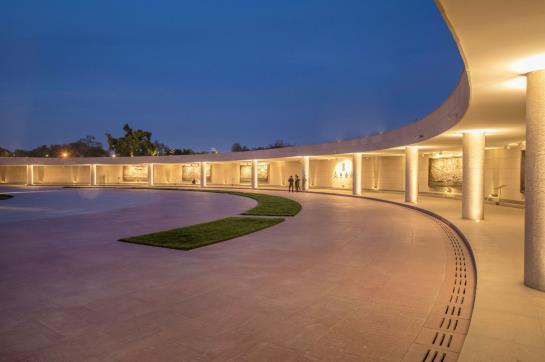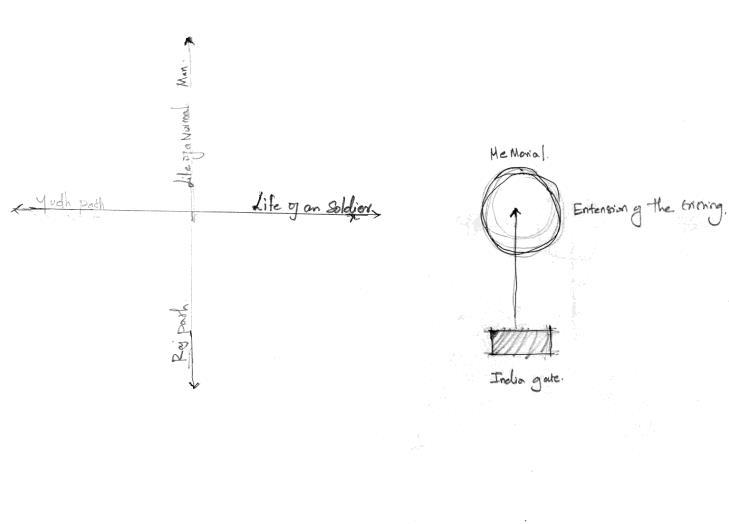
7 minute read
Figure 4-30 Context and design of central obelisk
from "SET IN STONE"
4.3.4 CENTRAL OBELISK
In National War Memorial, the central obelisk symbolizerising from the earth, meeting the sky, immortalizing the memory of the soldiers. The central obelisk and the opening out of the memorial intend to hold a subtle hierarchy to the India Gate and the Chattri.
Advertisement
In Chandigarh War memorial the central obelisk consists of three converging posts, which signify the three armed forces of India that are, the Army, the Navy, and the Air Force which work united for the protection of the country.
Figure 4-30 Context and design of central obelisk

Figure 4-31 Context and design of central obelisk
4.3.4 THE NAME PANELS: SYMBOLS OF REMEMBERANCE
Both the memorials tell the story of sacrifice of the brave soldiers by inscribing their names on stones – “setting in Stone” as a symbol of honoring them.
In the National War Memorial names are inscribed on self-interlocking granite blocks in the Tyag Chakra (The circle of sacrifice). Metaphorically represents the formation of the soldiers in the war.
As derived from the concept of chakravyuha the soldiers stand in the endless rows in the formation of concentric circles protecting the nation. The Circle has 8 segments. The base of the wall is made of concrete structure with self-interlocking granite blocks. The wall holds names of 25942 martyrs, who sacrificed their life post-independence for the Nation. The wall segments are categorically organized based on the timeline of the wars fought. It offers an experiential way of remembrance.
Rows and rows systemized chronologically outline an enormity of the loss, a physical echo of the absence, a memorial for an individual soldier, not a general monument.
The chronological choice for listing the names on the memorial plays a critical role. The names inscribed on the wall in the chronological order of their dates of casualty, shows the war as a series of individual human sacrifices. As one walks along the wall, one would observe that the passage along the wall is simultaneously a passage through time. This element of the design concept behind the National War Memorial helps the visitor to realize that immensity of the number of names and it serves as a constant reminder of the high price of war. In essence, a progression in time and the comprehension of the price of human lives that results from the various wars are what's memorialized.



Figure 4-32 Each granite block is made to shape precisely and represents a martyr, on which his name and ranks are engraved
In Chandigarh War Memorial Black Granite Plates are used to showcase the brave soldiers who sacrificed their lives for the nation. The striking feature is the reflectivity of the polished black granite wall.
The wall dematerializes as a form and allows the names to become the object, a pure and reflective surface that would allow visitors the chance to see themselves with the names.
The wall acts as a dark mirror into a shadowed mirrored image of the space, space we cannot enter and from which the names separate us, an interface between the world of the living and the world of the dead. The reflectivity of the memorial plays a critical role. When a viewer stands and faces the wall to examine a name, he or she is also examining a reflection of him or herself which is reflected back on the polished surface. This effect is striking and powerful, with the high level of polish, the wall produces very clear reflections.
Through the reflective surface, the viewer would find themselves being part of the wall. Thus, the space apart in front of the wall connects to a space apart that is seen through the surface of the wall.
Furthermore, the experience of the polished black granite wall is enhanced as one touch the surface of the wall and to touch the names. For instance, touching the wall with our hands, the hand is reflected back from the reflective surface of the wall. This directness gives a felt presence that a hand seems to be reaching forward from within the space of the wall.

Figure 4-33 Reflections creates connections between the world of living and their lost loved ones.
5.CONCLUSION
To conclude, having examined both case studies, we can draw in retrospect that the evolution in Indian memorial designs is largely a transformation from heroic figural sculptures to more conceptual installations such as the National War Memorial or the Chandigarh war Memorial. Although these two memorials have been accused of being too conceptual or abstract, we identify that both case studies participates in the ongoing exploration that challenges the classic and traditional roles of memorial while supplanting them with abstraction and space-making strategies. The design strategy in both case studies embraces the multiplicity of readings in its spatial aesthetics over the single reading of a statue memorial. Both case studies exemplify how to achieve a timeless status for the memorial design, but it is created within the context of a specific time and place that deeply influence that creation.
In both case studies the design of the memorial reinterprets symbols to convey meaning and to commemorate the persons that have lost their lives during war or from a catastrophic event. By examining both case studies, this article have brought attention and revealed a spectrum of emotive and aesthetic strategies of designing a memorial. This article identify that through the appropriation of symbols, meaning, and intention, a wide array of memories can be embedded simultaneously within a memorial: individual and collective, formal and informal, heroic and tragic.
From this dissertation, the critical questions that concern the design of memorials have been the language, form, and the content of memorials. The concerns to these questions are essentially the analysis of the emotive and aesthetic strategies; they relate to an intriguingly varied, yet at the same time a uniform sensibility and form. This thought on aesthetics help expose a prevalent assumption that memorials must either "serve a didactic or cathartic function; they must either instruct or initiate a healing process”.
Having examined both case studies, the National War Memorial and the Chandigarh War Memorial, both re-evaluate these aesthetic assumptions that memorial sites are locations for either initiating private healing process or re-establishing national unity. In keeping with this idea these memorials help visitors establish a personal and emotional connection to the persons or events being honored. In the aesthetic of remembrance in memorial architecture, remembrance does not exist in isolation but rather within preexisting context of the personal and the collective social memory of persons or events.
The aesthetic of remembrance in memorial architecture is a dialogue built upon the consciousness of how we are able to remember and learn from our past. In the building of memory in memorial architecture, memorial design can invite people not only to remember but also to think, speak, and behave anew. This paper hopes to stimulate and inform, as well as laying a foundation upon which can built the ideas that will expand our knowledge of memorial architecture.
“Quartered in snow, Silent to remain. When the bugle calls, They shall rise and march again” The Scroll of honor, Siachen base camp.
6.REFERENCE
[1]T. Stoppani, "The Interdisciplinary Handbook on Trauma and Culture", PH.D., School of Art Architecture and Design, Leeds Beckett University, Broadcasting Place, Leeds LS2 9EN United Kingdom, 2015.
[2]S. TANOVIC, "Memory in architecture: Contempory memorial projects and their predecessors", Post Graduation, University of Sarajevo, 2015.
[3]S. Muthe, "A Voice for Public Memory: A Comparison Between the Memorial Practices in India and the United States of America to Propose a Suitable Response to the 26/11 Attacks in Mumbai", Masters Thesis, University of Pennsylvania, Philadelphia, PA., 2016.
[4]A. Dutta, The Chandigarh War Memorial, 1st ed. Chandigarh, 2021.
[5]R. Chhina, "Last Post Indian War Memorials Around the World", United Service Institution of India, 2014.
[6]T. Wen, "The Aesthetics of Remembrance: Building Memory in Memorial Architecture", Issuu, 2021. [Online]. Available: https://issuu.com/wenstudio/docs/the_aesthetics_of_remembrance_twen. [Accessed: 18February- 2021].
[7]H. Nayar, "B.Arch Thesis - MEMORIAL OF HUMANITY AND THE MUSEUM OF RIOTS, at Ayodhya - ArchitectureLive!", ArchitectureLive!, 2021. [Online]. Available: https://architecturelive.in/b-arch-thesis-memorial-of-humanity-and-the-museum-of-riots-atayodhya-by-harish-nayar/. [Accessed: 27- February- 2021].
[8]M. El-kurdi, "On War, Architecture and Memory: The Non-Memorial", Issuu, 2021. [Online]. Available: https://issuu.com/melkurdi/docs/msc_thesis. [Accessed: 05- Feb- 2021].
[9]"National War Memorial", Webedesignlab.com, 2021. [Online]. Available: https://www.webedesignlab.com/works/national-war-memorial. [Accessed:1- May- 2021].
[10]"National War Memorial, New Delhi India / WeBe Design Lab", ArchDaily, 2021. [Online]. Available: https://www.archdaily.com/936907/national-war-memorial-new-delhi-india-webedesign-lab. [Accessed: 01- May- 2021].
[11]"National War Memorial, Delhi: WeBe Design Lab", MATTER, 2018. [Online]. Available: https://thinkmatter.in/2020/06/22/nwm/. [Accessed: 01- May- 2021].










